2016 HONDA CIVIC rear view mirror
[x] Cancel search: rear view mirrorPage 7 of 590
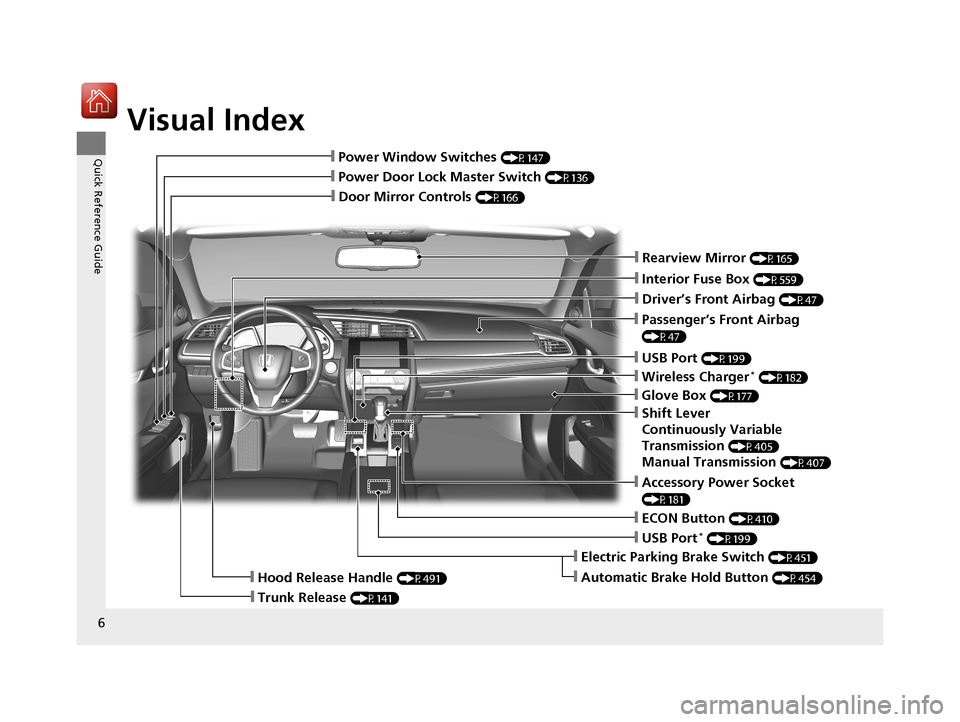
Visual Index
6
Quick Reference Guide
❙Door Mirror Controls (P166)
❙Passenger’s Front Airbag
(P47)
❙Glove Box (P177)
❙Rearview Mirror (P165)
❙Accessory Power Socket
(P181)
❙Hood Release Handle (P491)
❙Trunk Release (P141)
❙Power Door Lock Master Switch (P136)
❙Power Window Switches (P147)
❙Interior Fuse Box (P559)
❙Driver’s Front Airbag (P47)
❙USB Port (P199)
❙Shift Lever
Continuously Variable
Transmission
(P405)
Manual Transmission (P407)
❙ECON Button (P410)
❙Electric Parking Brake Switch (P451)
❙Automatic Brake Hold Button (P454)
❙USB Port* (P199)
❙Wireless Charger* (P182)
16 CIVIC 4D-31TBA6000.book 6 ページ 2015年8月31日 月曜日 午後5時56分
Page 9 of 590

Visual Index
8
Quick Reference Guide❙Maintenance Under the Hood (P489)
❙Windshield Wipers (P160, 514)
❙Tires (P516, 537)
❙Fog Lights* (P159, 506)
❙Power Door Mirrors (P166)
❙How to Refuel (P471)
❙High-Mount Brake Light (P513)
❙Emergency Trunk Release Lever (P143)
❙Opening/Closing the Trunk (P141)
❙Multi-View Rear Camera (P468)
❙Door Lock/Unlock Control (P127)
❙Side Turn Signal Lights* (P156, 510)
❙Headlights (P156, 504)
❙Front Turn Signal Lights (P156, 508)
❙Parking/Daytime Running Lights (P156, 510)
❙Front Side Marker Lights (P509)
❙Taillights (P512)
❙Back-Up Lights (P512)
❙Brake Lights (P511)
❙Rear Turn Signal Lights (P511)
❙Tail/Rear Side Marker Lights (P511)
❙Trunk Release Button* (P141)
❙License Plate Light (P512)
16 CIVIC 4D-31TBA6000.book 8 ページ 2015年8月31日 月曜日 午後5時56分
Page 122 of 590
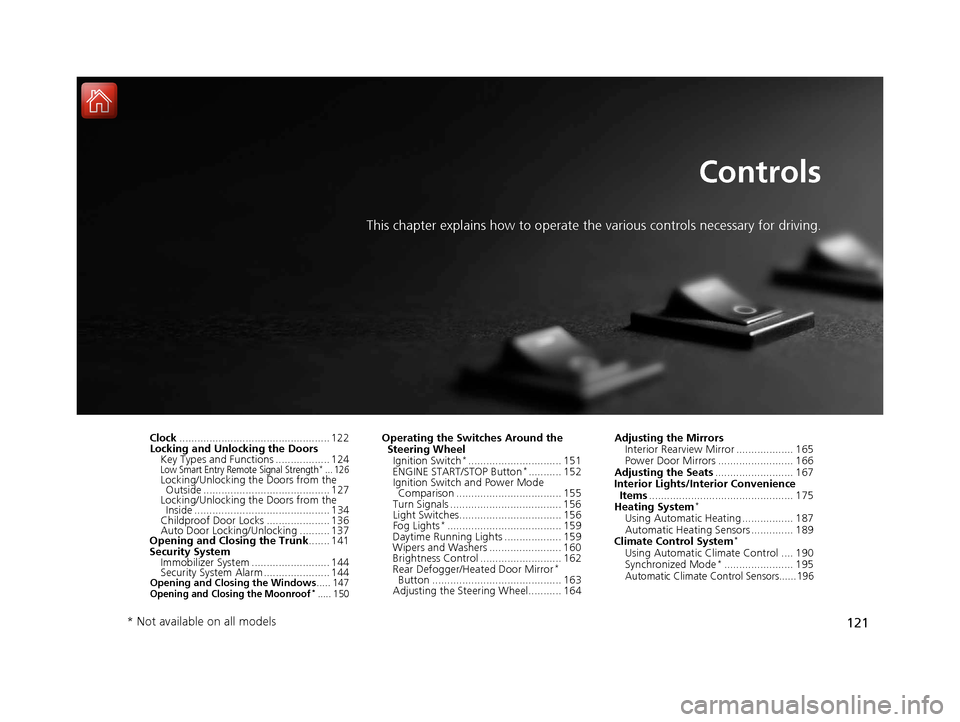
121
Controls
This chapter explains how to operate the various controls necessary for driving.
Clock.................................................. 122
Locking and Unlocking the Doors Key Types and Functions .................. 124
Low Smart Entry Remote Signal Strength*... 126Locking/Unlocking the Doors from the Outside .......................................... 127
Locking/Unlocking the Doors from the Inside ............................................. 134
Childproof Door Locks ..................... 136
Auto Door Locking/Unlocking .......... 137
Opening and Closing the Trunk ....... 141
Security System Immobilizer System .......................... 144
Security System Alarm ...................... 144
Opening and Closing the Windows ..... 147Opening and Closing the Moonroof*..... 150
Operating the Switches Around the
Steering Wheel
Ignition Switch
*............................... 151
ENGINE START/STOP Button*........... 152
Ignition Switch and Power Mode Comparison ................................... 155
Turn Signals ..................................... 156
Light Switches.................................. 156
Fog Lights
*...................................... 159
Daytime Running Lights ................... 159
Wipers and Washers ........................ 160
Brightness Control ........................... 162
Rear Defogger/Heat ed Door Mirror
*
Button ........................................... 163
Adjusting the Steering Wheel........... 164 Adjusting the Mirrors
Interior Rearview Mirror ................... 165
Power Door Mirrors ......................... 166
Adjusting the Seats .......................... 167
Interior Lights/Interior Convenience
Items ................................................ 175
Heating System
*
Using Automatic Heating ................. 187
Automatic Heating Sensors .............. 189
Climate Control System
*
Using Automatic Climate Control .... 190
Synchronized Mode*....................... 195Automatic Climate Control Sensors......196
* Not available on all models
16 CIVIC 4D-31TBA6000.book 121 ページ 2015年8月31日 月曜日 午後5時56分
Page 166 of 590
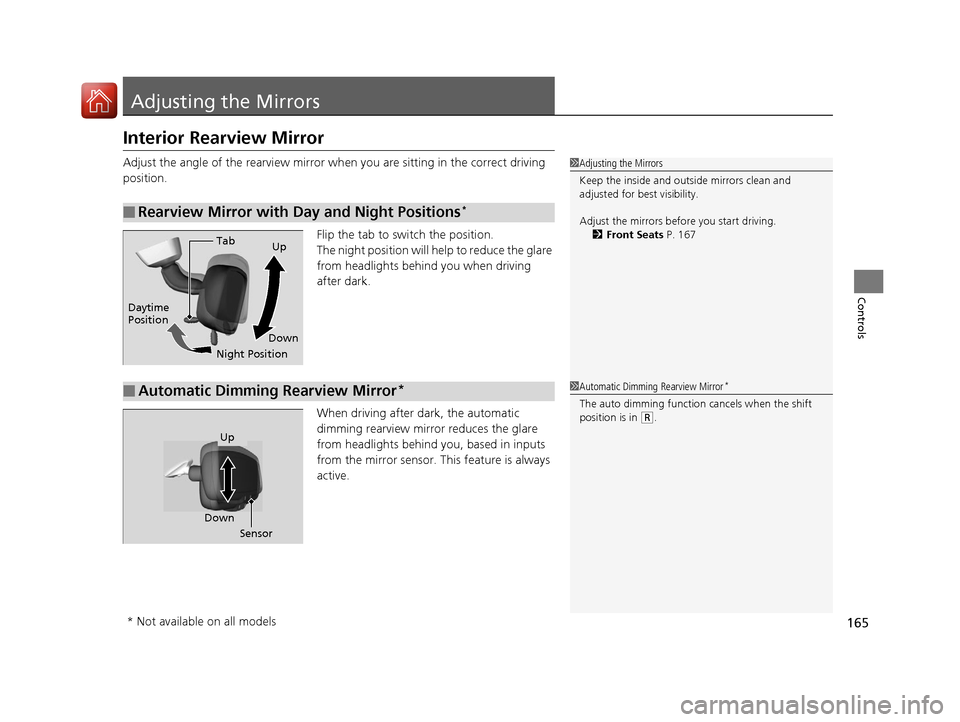
165
Controls
Adjusting the Mirrors
Interior Rearview Mirror
Adjust the angle of the rearview mirror when you are sitting in the correct driving
position.
Flip the tab to switch the position.
The night position will help to reduce the glare
from headlights behind you when driving
after dark.
When driving after dark, the automatic
dimming rearview mirror reduces the glare
from headlights behind you, based in inputs
from the mirror sensor. This feature is always
active.
■Rearview Mirror with Day and Night Positions*
1Adjusting the Mirrors
Keep the inside and out side mirrors clean and
adjusted for best visibility.
Adjust the mirrors before you start driving. 2 Front Seats P. 167
Tab
Daytime
Position
Night PositionUp
Down
■Automatic Dimming Rearview Mirror*1 Automatic Dimming Rearview Mirror*
The auto dimming function cancels when the shift
position is in
(R.
Sensor
Down
Up
* Not available on all models
16 CIVIC 4D-31TBA6000.book 165 ページ 2015年8月31日 月曜日 午後5時56分
Page 415 of 590
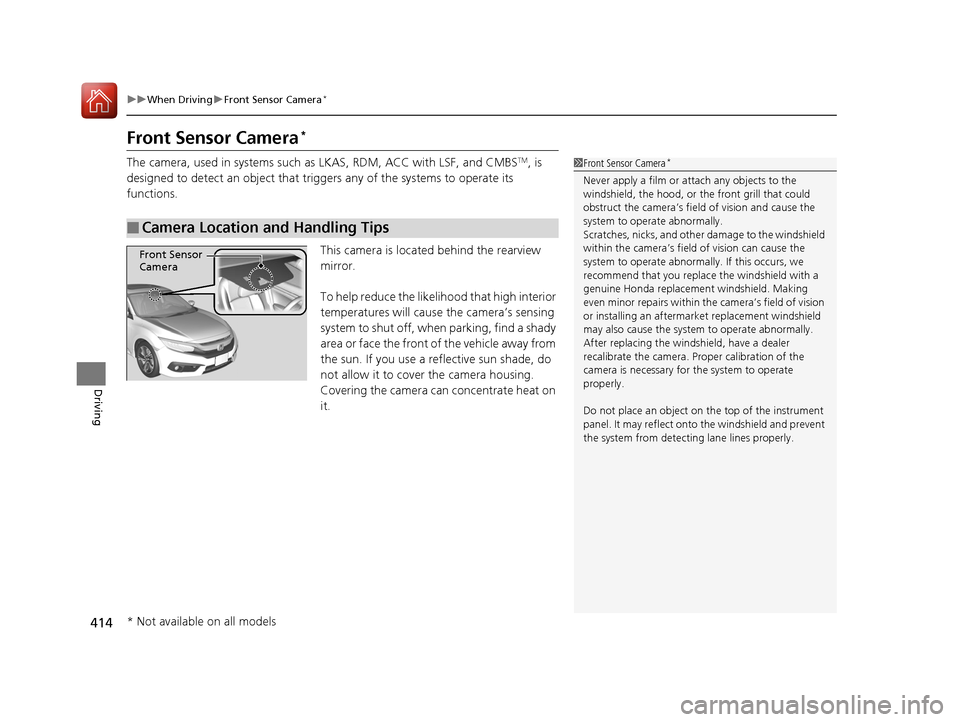
414
uuWhen Driving uFront Sensor Camera*
Driving
Front Sensor Camera*
The camera, used in systems such as LKAS, RDM, ACC with LSF, and CMBSTM, is
designed to detect an object that triggers any of the systems to operate its
functions.
This camera is located behind the rearview
mirror.
To help reduce the likelihood that high interior
temperatures will cause the camera’s sensing
system to shut off, when parking, find a shady
area or face the front of the vehicle away from
the sun. If you use a reflective sun shade, do
not allow it to cover the camera housing.
Covering the camera can concentrate heat on
it.
■Camera Location and Handling Tips
1 Front Sensor Camera*
Never apply a film or attach any objects to the
windshield, the hood, or the front grill that could
obstruct the camera’s fiel d of vision and cause the
system to operate abnormally.
Scratches, nicks, and othe r damage to the windshield
within the camera’s fiel d of vision can cause the
system to operate abnormall y. If this occurs, we
recommend that you replac e the windshield with a
genuine Honda replacem ent windshield. Making
even minor repairs within th e camera’s field of vision
or installing an aftermarket replacement windshield
may also cause the system to operate abnormally.
After replacing the winds hield, have a dealer
recalibrate the camera. Pr oper calibration of the
camera is necessary for the system to operate
properly.
Do not place an object on the top of the instrument
panel. It may reflect onto the windshield and prevent
the system from detecting lane lines properly.
Front Sensor
Camera
* Not available on all models
16 CIVIC 4D-31TBA6000.book 414 ページ 2015年8月31日 月曜日 午後5時56分
Page 417 of 590
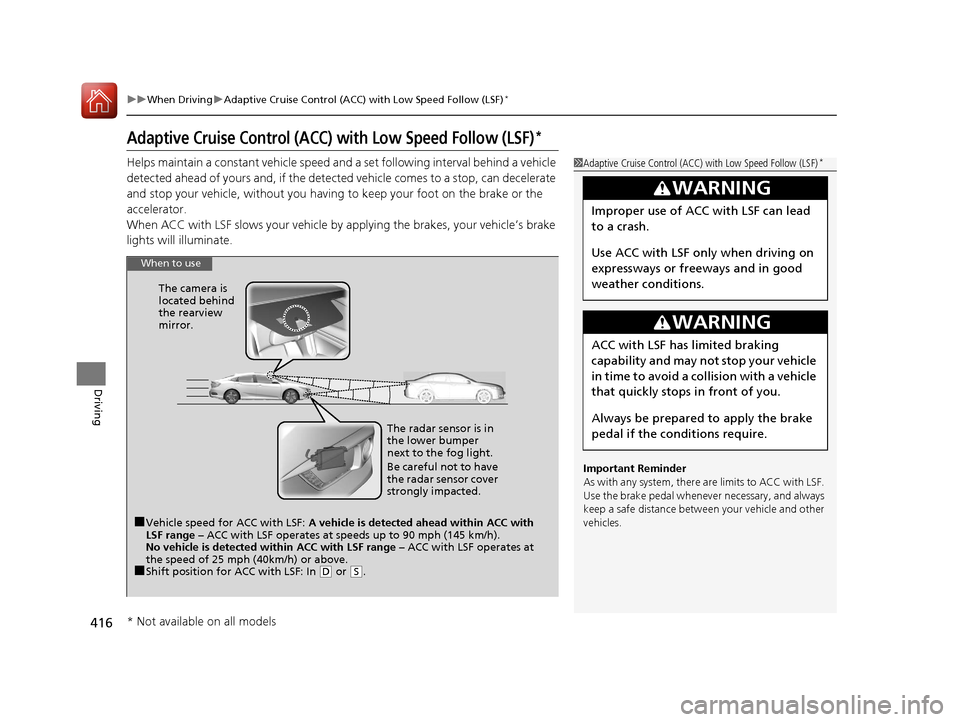
416
uuWhen Driving uAdaptive Cruise Control (ACC) with Low Speed Follow (LSF)*
Driving
Adaptive Cruise Control (ACC) with Low Speed Follow (LSF)*
Helps maintain a constant vehicle speed an d a set following interval behind a vehicle
detected ahead of yours and, if the detect ed vehicle comes to a stop, can decelerate
and stop your vehicle, without you having to keep your foot on the brake or the
accelerator.
When ACC with LSF slows your vehicle by applying the brakes, your vehicle’s brake
lights will illuminate.1 Adaptive Cruise Control (ACC) with Low Speed Follow (LSF)*
Important Reminder
As with any system, there are limits to ACC with LSF.
Use the brake pedal whenever necessary, and always
keep a safe distance between your vehicle and other
vehicles.
3WARNING
Improper use of ACC with LSF can lead
to a crash.
Use ACC with LSF only when driving on
expressways or freeways and in good
weather conditions.
3WARNING
ACC with LSF has limited braking
capability and may not stop your vehicle
in time to avoid a collision with a vehicle
that quickly stops in front of you.
Always be prepared to apply the brake
pedal if the cond itions require.
When to use
■Vehicle speed for ACC with LSF: A vehicle is detected ahead within ACC with
LSF range – ACC with LSF operates at speeds up to 90 mph (145 km/h).
No vehicle is detected within ACC with LSF range – ACC with LSF operates at
the speed of 25 mph (40km/h) or above.
■Shift position for ACC with LSF: In ( D or (S. The radar sensor is in
the lower bumper
next to the fog light.
Be careful not to have
the radar sensor cover
strongly impacted.
The camera is
located behind
the rearview
mirror.
* Not available on all models
16 CIVIC 4D-31TBA6000.book 416 ページ 2015年8月31日 月曜日 午後5時56分
Page 428 of 590
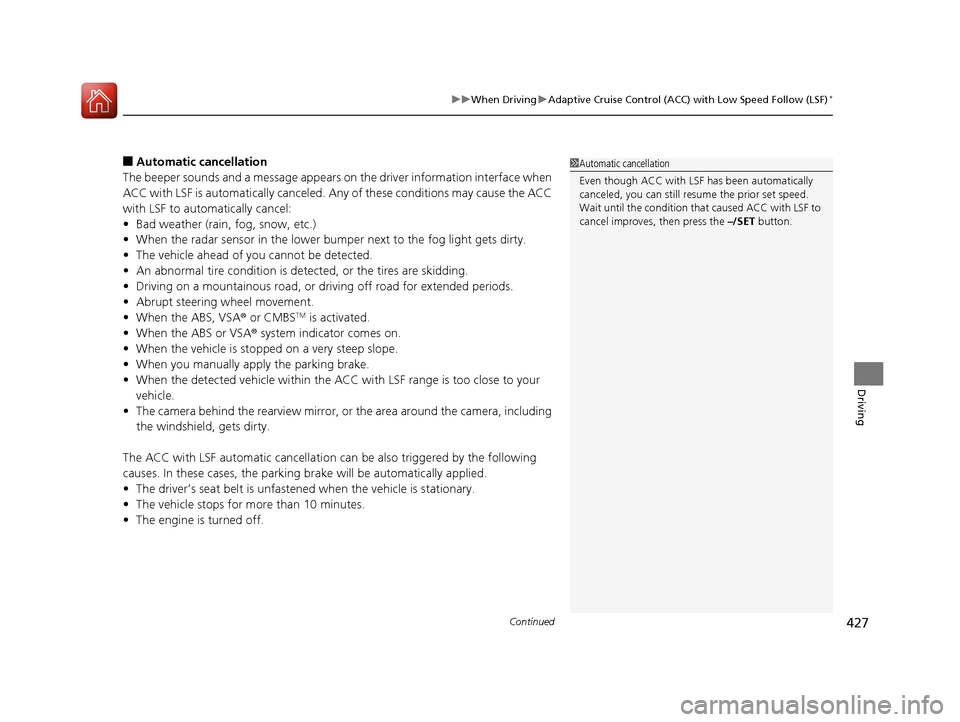
Continued427
uuWhen Driving uAdaptive Cruise Control (ACC) with Low Speed Follow (LSF)*
Driving
■Automatic ca ncellation
The beeper sounds and a message appears on the driver information interface when
ACC with LSF is automatically canceled. Any of these conditions may cause the ACC
with LSF to automatically cancel:
• Bad weather (rain, fog, snow, etc.)
• When the radar sensor in the lower bum per next to the fog light gets dirty.
• The vehicle ahead of yo u cannot be detected.
• An abnormal tire condition is detected, or the tires are skidding.
• Driving on a mountainous road, or driving off road for extended periods.
• Abrupt steering wheel movement.
• When the ABS, VSA ® or CMBS
TM is activated.
• When the ABS or VSA ® system indicator comes on.
• When the vehicle is stopped on a very steep slope.
• When you manually apply the parking brake.
• When the detected vehicle within the AC C with LSF range is too close to your
vehicle.
• The camera behind the rearview mirror, or the area around the camera, including
the windshield, gets dirty.
The ACC with LSF automatic cancellation ca n be also triggered by the following
causes. In these cases, the parking brake will be automatically applied.
• The driver’s seat belt is unfastene d when the vehicle is stationary.
• The vehicle stops for more than 10 minutes.
• The engine is turned off.
1Automatic cancellation
Even though ACC with LSF has been automatically
canceled, you can still resu me the prior set speed.
Wait until the condition that caused ACC with LSF to
cancel improves, then press the –/SET button.
16 CIVIC 4D-31TBA6000.book 427 ページ 2015年8月31日 月曜日 午後5時56分
Page 431 of 590
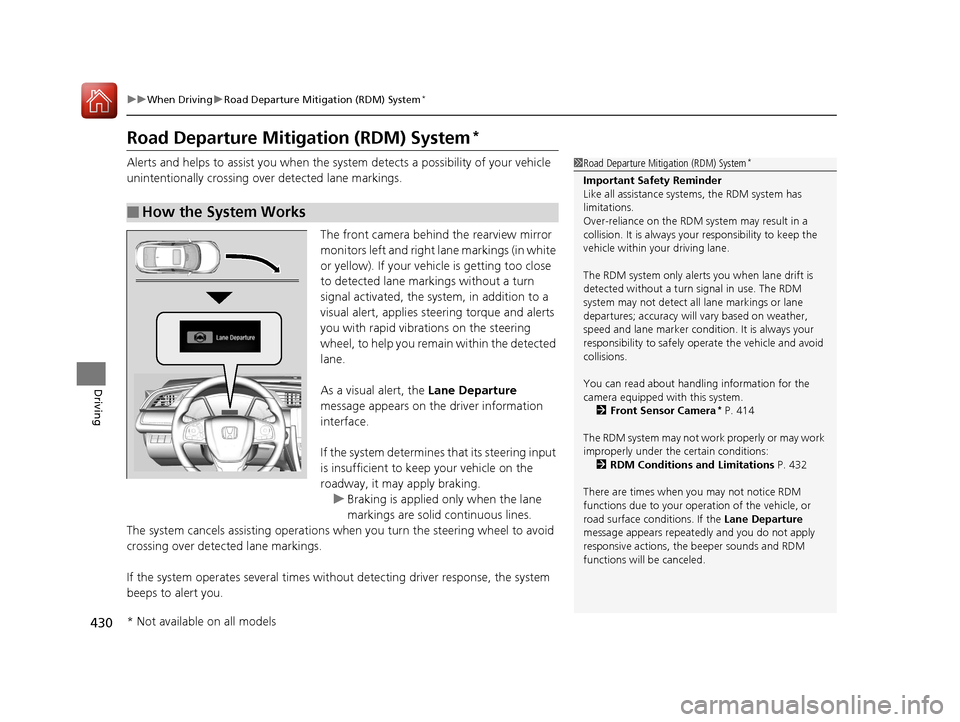
430
uuWhen Driving uRoad Departure Mitigation (RDM) System*
Driving
Road Departure Mitigation (RDM) System*
Alerts and helps to assist you when the sy stem detects a possibility of your vehicle
unintentionally crossing over detected lane markings.
The front camera behind the rearview mirror
monitors left and right lane markings (in white
or yellow). If your vehicle is getting too close
to detected lane markings without a turn
signal activated, the system, in addition to a
visual alert, applies st eering torque and alerts
you with rapid vibrations on the steering
wheel, to help you remain within the detected
lane.
As a visual alert, the Lane Departure
message appears on the driver information
interface.
If the system determines that its steering input
is insufficient to keep your vehicle on the
roadway, it may apply braking. u Braking is applied only when the lane
markings are solid continuous lines.
The system cancels assisting operations wh en you turn the steering wheel to avoid
crossing over detected lane markings.
If the system operates several times without detecting driver response, the system
beeps to alert you.
■How the System Works
1 Road Departure Mitigation (RDM) System*
Important Safety Reminder
Like all assistance systems, the RDM system has
limitations.
Over-reliance on the RDM system may result in a
collision. It is always your responsibility to keep the
vehicle within your driving lane.
The RDM system only alerts you when lane drift is
detected without a turn signal in use. The RDM
system may not detect all lane markings or lane
departures; accuracy will vary based on weather,
speed and lane marker condi tion. It is always your
responsibility to sa fely operate the vehicle and avoid
collisions.
You can read about handling information for the
camera equipped with this system.
2 Front Sensor Camera
* P. 414
The RDM system may not wo rk properly or may work
improperly under the certain conditions:
2 RDM Conditions and Limitations P. 432
There are times when you may not notice RDM
functions due to your opera tion of the vehicle, or
road surface conditions. If the Lane Departure
message appears repeated ly and you do not apply
responsive actions, the beeper sounds and RDM
functions will be canceled.
* Not available on all models
16 CIVIC 4D-31TBA6000.book 430 ページ 2015年8月31日 月曜日 午後5時56分